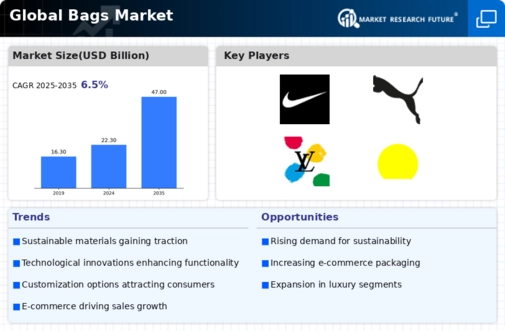Top Industry Leaders in the Bags Market

The bags market, encompassing a wide array of products from handbags to backpacks, is a competitive and dynamic industry driven by consumer preferences, fashion trends, and functionality. As of 2023, key players in this market have implemented various strategies to gain a competitive edge, navigating the challenges posed by changing consumer behavior and market dynamics.
Key Players:
Nike
Inc. (US)
Adidas AG (Germany)
Samsonite International SA (Hong Kong)
VF Corporation (US)
Puma SE (Germany)
Louis Vuitton (France)
Delsey (France)
Hershel Supply Company (Canada)
Jensen Lee (US)
and Belmil (Serbia)
Strategies Adopted By Bags Key Players:
The bags market deploy various strategies to maintain and enhance their market positions. Product innovation is a common strategy, with an emphasis on introducing new designs, materials, and functionalities. Brands also collaborate with influencers and celebrities to enhance brand visibility and appeal to specific consumer segments. Digital marketing and e-commerce play a significant role, with companies investing in online platforms to reach a broader audience and streamline the purchasing process. Pricing strategies, including limited edition releases and tiered product lines, are employed to cater to different consumer preferences and budgets.
Market Share Analysis:
The bags industry involves considering multiple factors. Brand reputation is a crucial determinant, influencing consumer trust and loyalty. The ability to anticipate and respond to changing fashion trends, incorporating sustainable practices, and offering a diverse product portfolio are significant contributors to market share. Distribution efficiency, both through traditional retail channels and e-commerce platforms, is vital for reaching a wide consumer base. Additionally, the quality of materials used, production efficiency, and the ability to balance exclusivity with accessibility impact market share dynamics.
News & Emerging Companies:
The bags market has seen the emergence of new players focusing on innovative designs, sustainable practices, and unique selling propositions. Emerging companies often leverage digital marketing and e-commerce platforms to establish a presence in a competitive market. News in the industry typically revolves around collaborations with influencers, the launch of limited-edition collections, and efforts to incorporate sustainable materials into production processes.
Industry Trends:
The bags market often highlights trends in materials, design, and sustainability. Companies are increasingly investing in eco-friendly practices, incorporating recycled materials and ethical sourcing into their production processes. The integration of technology, such as smart features in bags, is also gaining traction, showcasing a strategy to tap into tech-savvy consumer segments. Investments in digital marketing, particularly through social media platforms, continue to be a prevalent trend, as brands seek to engage with their audience and drive online sales.
Current investment trends reveal a focus on supply chain efficiency and sustainability. Companies are exploring ways to reduce their environmental footprint, from raw material sourcing to manufacturing processes. The adoption of circular economy principles, such as recycling programs and product durability, aligns with the growing demand for responsible and ethical consumer choices.
Competitive Scenario:
The bags market is highly competitive, with players operating across various segments, including luxury, accessible luxury, and functional everyday bags. The competition extends beyond product design and features to brand image, marketing strategies, and customer service. Luxury brands often emphasize exclusivity, craftsmanship, and brand heritage, while accessible luxury and functional brands prioritize a combination of style, functionality, and affordability.
The rise of direct-to-consumer models and the increasing importance of e-commerce have reshaped the competitive scenario. Brands that effectively navigate the digital landscape, establish a strong online presence, and create seamless customer experiences are better positioned to thrive in the evolving market.
Recent Development
Herschel Supply Co. made headlines with the launch of a sustainable backpack line, incorporating recycled materials and environmentally friendly manufacturing practices. This development aligned with the growing consumer awareness of environmental issues, showcasing the brand's commitment to responsible production. Michael Kors, recognizing the increasing importance of digital channels, announced a comprehensive digital marketing strategy, leveraging social media platforms and influencers to enhance brand engagement and drive online sales.
Samsonite International S.A., a leader in travel bags, invested in research and development to introduce innovative features in its luggage lines, such as smart tracking systems and lightweight yet durable materials. This move reflected the company's commitment to addressing the evolving needs of modern travelers and maintaining its position as a leader in the travel bags segment.


